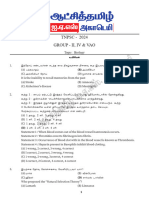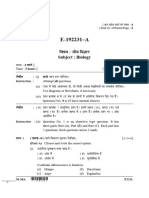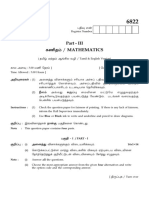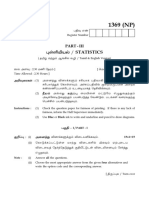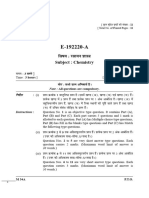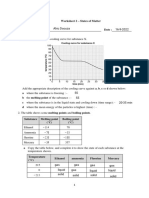Science 4
Science 4
Uploaded by
rajaCopyright:
Available Formats
Science 4
Science 4
Uploaded by
rajaOriginal Title
Copyright
Available Formats
Share this document
Did you find this document useful?
Is this content inappropriate?
Copyright:
Available Formats
Science 4
Science 4
Uploaded by
rajaCopyright:
Available Formats
No.
of Printed Pages : 11
2345
2345
2345
2345
2345
2345
6829
!6829Science!
2345
2345 £vÄ Gs
2345
2345
2345
2345 Register Number
2345
2345
2345
2345
2345
2345
2345
2345
Part - III
AÔ¯À / SCIENCE
( uªÌ ©ØÖ® B[Q» ÁÈ / Tamil & English Version)
Põ» AÍÄ : 3.00 ©o ÷|µ® ] [ ö©õzu ©v¨ö£sPÒ : 75
Time Allowed : 3.00 Hours ] [ Maximum Marks : 75
AÔÄøµPÒ : (1) AøÚzx ÂÚõUPЮ \›¯õP Aa_¨ £vÁõQ EÒÍuõ GߣuøÚ
\›£õºzxU öPõÒÍÄ®. Aa_¨£vÂÀ SøÓ°¸¨¤ß AøÓU
PsPõo¨£õÍ›h® EhÚi¯õP öu›ÂUPÄ®.
(2) }»® AÀ»x P¸¨¦ ø©°øÚ GÊxÁuØS® AiU÷PõikÁuØS®
£¯ß£kzu ÷Ásk®. £h[PÒ ÁøµÁuØS ö£ß]À £¯ß£kzuÄ®.
Instructions : (1) Check the question paper for fairness of printing. If there is any lack of
fairness, inform the Hall Supervisor immediately.
(2) Use Blue or Black ink to write and underline and pencil to draw
diagrams.
SÔ¨¦ : CÆÂÚõzuõÒ |õßS £SvPøÍU öPõshx.
Note : This question paper contains four parts.
£Sv & I / PART -I
SÔ¨¦ : (i) AøÚzx ÂÚõUPÐUS® Âøh¯ÎUPÄ®. 12x1=12
(ii) öPõkUP¨£mkÒÍ |õßS ÂøhPÎÀ ªPÄ® Hئøh¯ Âøh°øÚ
÷uº¢öukzx SÔ±mkhß Âøh°øÚ²® ÷\ºzx GÊuÄ®.
Note : (i) Answer all the questions.
(ii) Choose the most appropriate answer from the given four alternatives
and write the option code and the corresponding answer.
[ v¸¨¦P / Turn over
6829 2
1. S ö»ß]ß E¸¨ö£¸UP©õÚx G¨÷£õx® __________ ©v¨¦øh¯x.
(A) ÷|ºUSÔ
(B) GvºUSÔ
(C) ÷|ºUSÔ AÀ»x GvºUSÔ
(D) _È
Magnification of a convex lens is always :
(a) Positive
(b) Negative
(c) Either positive (or) negative
(d) Zero
2. RÌUPsh G¢u ÂøÚ°À ÷\´ EmP¸Âß {øÓ GsoÀ |õßS SøÓ²® ?
(A) α ]øuÄ (B) β ]øuÄ
(C) γ ]øuÄ (D) {³mµõß ]øuÄ
In which of the following reaction, the mass number decreases by four of the
daughter nucleus ?
(a) α decay (b) β decay
(c) γ decay (d) neutron decay
3. }›ß Qµõ® ‰»UTÖ {øÓ __________.
(A) 2 Q (B) 16 Q (C) 18 Q (D) 8 Q
The gram molecular mass of water is :
(a) 2g (b) 16 g (c) 18 g (d) 8g
3 6829
4. RÌUPshÁØÖÒ Gx \ºÁUPøµ¨£õß ?
(A) A]m÷hõß (B) ö£ß^ß
(C) }º (D) BÀPíõÀ
Which of the following is the universal solvent ?
(a) Acetone (b) Benzene
(c) Water (d) Alcohol
5. ö£¯›ku¼ß£i BÀiøíkUPõP ÷\ºUP¨£k® Cµshõ® {ø»
IUPAC
¤ßöÚõmk __________.
(A) BÀ (B) B°U Aª»®
(C) HÀ (D) Kß
The secondary suffix used in IUPAC nomenclature of an aldehyde is __________.
(a) -ol (b) -oic acid
(c) -al (d) -one
6. C¸ÁõÌÂPÎß Cu¯® __________ AøÓPÒ öPõshx.
(A) 3 (B) 4 (C) 2 (D) 5
The heart of amphibians possess __________ chambers.
(a) 3 (b) 4 (c) 2 (d) 5
[ v¸¨¦P / Turn over
6829 4
7. Qµ¨ _ÇØ] __________ CÀ |øhö£ÖQÓx.
(A) £_[PoP®
(B) ø©m÷hõPõsm›¯õÂß EmTÌ©®
(C) ¦Óz÷uõÀ xøÍ
(D) ø©m÷hõPõsm›¯õÂß Em¦Óa \ÆÄ
Kreb’s cycle takes place in __________.
(a) chloroplast
(b) mitochondrial matrix
(c) stomata
(d) inner mitochondrial membrane
8. C¸ •øÚ {³µõßPÒ Põn¨£k® Ch® __________.
(A) Ps ÂÈzvøµ (B) ö£¸‰øͨ ¦Óo
(C) Áͺ P¸ (D) _Áõ\ G¤w¼¯®
Bipolar neurons are found in :
(a) retina of eye (b) cerebral cortex
(c) embryo (d) respiratory epithelium
9. ]ß÷Pª°ß ÂøÍÁõÀ E¸ÁõÁx __________.
(A) `ì÷£õºPÒ (B) öPõÛi¯õ
(C) ø\÷Põm (D) QÍõª÷hõì÷£õºPÒ
Syngamy results in the formation of __________.
(a) zoospores (b) conidia
(c) zygote (d) chlamydospores
5 6829
10. ö£õ¸zxP :
(1) \õºU÷Põ©õ (i) AvP¨£i¯õÚ £]
(2) Põº]÷Úõ©õ (ii) AvP¨£i¯õÚ uõP®
(3) £õ¼i¨]¯õ (iii) Cøn¨¦zv_ ¦ØÖ÷|õ´
(4) £õ¼÷£â¯õ (iv) Á°ØÖ ¦ØÖ÷|õ´
(A) (1)-(iii), (2)-(iv), (3)-(ii), (4)-(i)
(B) (1)-(iv), (2)-(iii), (3)-(i), (4)-(ii)
(C) (1)-(i), (2)-(iii), (3)-(iv), (4)-(ii)
(D) (1)-(iv), (2)-(i), (3)-(ii), (4)-(iii)
Match the following :
(1) Sarcoma (i) Excessive hunger
(2) Carcinoma (ii) Excessive thirst
(3) Polydipsia (iii) Connective tissue cancer
(4) Polyphagia (iv) Stomach cancer
(a) (1)-(iii), (2)-(iv), (3)-(ii), (4)-(i)
(b) (1)-(iv), (2)-(iii), (3)-(i), (4)-(ii)
(c) (1)-(i), (2)-(iii), (3)-(iv), (4)-(ii)
(d) (1)-(iv), (2)-(i), (3)-(ii), (4)-(iii)
11. G¢u {PÌa]°ß Põµn©õP 9 : 3 : 3 : 1 E¸ÁõQÓx ?
(A) ¤›uÀ (B) SÖU÷P P»zuÀ
(C) \õº¤ßÔ Jx[SuÀ (D) Jk[S ußø©
9 : 3 : 3 : 1 ratio is due to :
(a) Segregation (b) Crossing over
(c) Independent assortment (d) Recessiveness
[ v¸¨¦P / Turn over
6829 6
12. Ámhõµ CÚ uõÁµÂ¯À GßÝ® ö\õÀø» •uß •u¼À AÔ•P¨£kzv¯Áº :
(A) öPõµõÚõ (B) J.W. íõºìö£ºPº
(C) öµõÚõÀk µõì (D) î²÷Põ i ›ì
The term Ethnobotany was coined by :
(a) Khorana (b) J.W. Harshberger
(c) Ronald Ross (d) Hugo de Vries
£Sv & II / PART - II
SÔ¨¦ : GøÁ÷¯Ý® HÊ ÂÚõUPÐUS Âøh¯ÎUPÄ®. ÂÚõ Gs 22 &US
Pmhõ¯©õP Âøh¯ÎUPÄ®. 7x2=14
Note : Answer any seven questions. Question No. 22 is Compulsory.
13. {ø»©® – Áøµ¯ÖUPÄ®. Auß ÁøPPÒ ¯õøÁ ?
Define inertia. Give its classification.
14. ÁõÚ® Hß }» {Ó©õPz ÷uõßÖQÓx ?
Why does the sky appear blue in colour ?
15. J¸ P÷»õ› – Áøµ¯ÖUPÄ®.
Define one Calorie.
16. AÁPõm÷µõ Âv°ß £¯ß£õkPÎÀ H÷uÝ® CµsiøÚU TÖP.
Mention any two applications of Avogadro’s Law.
7 6829
17. Amøh°À Põn¨£k® Jmkso uPÁø©¨¦PøÍ GÊxP.
List out the parasitic adaptations in leech.
18. ‰øÍø¯¨ £õxPõ¨£õP øÁzv¸UP EuÄ® EÖ¨¦PÒ ¯õøÁ ?
What are the structures involved in the protection of brain ?
19. öPõkUP¨£mkÒÍ £hzvÀ A, B, C ©ØÖ® D BQ¯ £õP[PøÍ Aøh¯õÍ®
PõnÄ®.
Identify the parts A, B, C and D in the given figure.
20. ©µ¦¨ ö£õÔ°¯À – Áøµ¯ÖUPÄ®.
Define genetic engineering.
21. ì¤øµmk (SPRITE) GßÓõÀ GßÚ ?
What is Sprite ?
22. 2 Q.Q {øÓÁÊÄøh¯ J¸ Pv›¯UP¨ ö£õ¸ÍõÚx AqUP¸ CønÂß÷£õx
öÁΰk® ö©õzu BØÓø»U PnUQkP.
Calculate the amount of energy released when a radioactive substance undergoes
fusion and results in a mass defect of 2 kg.
[ v¸¨¦P / Turn over
6829 8
£Sv & III / PART - III
SÔ¨¦ : GøÁ÷¯Ý® HÊ ÂÚõUPÐUS Âøh¯ÎUPÄ®. ÂÚõ Gs 32 &US
Pmhõ¯©õP Âøh¯ÎUPÄ®. 7x4=28
Note : Answer any seven questions. Question No. 32 is Compulsory.
23. Âø\°ß \©ß£õmøh {³mhÛß Cµshõ® Âv ‰»® u¸Â.
Deduce the equation of force using Newton’s Second Law of Motion.
24. Qmh¨£õºøÁ ©ØÖ® yµ¨£õºøÁ SøÓ£õkPøÍ ÷ÁÖ£kzxP.
Differentiate the eye defects : Myopia and Hypermetropia.
25. (A) «ö¯õ¼ AvºÄÖuÀ GßÓõÀ GßÚ ?
(B) J¼ Gvöµõ¼zuÀ GßÓõÀ GßÚ ?
(a) What do you understand by the term Ultrasonic Vibration ?
(b) What is meant by reflection of sound ?
26. (A) Cµ\UP»øÁ GßÓõÀ GßÚ ? GkzxUPõmk u¸P.
(B) uõªµzvß H÷uÝ® Cµsk £¯ß£õkPøÍ TÖP.
(a) What is an amalgam ? Give an example.
(b) Mention any two uses of copper.
27. ÷\õ¨¤ß y´ø©¯õUPÀ •øÓø¯ ÂÍUSP.
Explain the mechanism of cleansing action of soap.
9 6829
28. (A) ©»¸® uõÁµ[PÎÀ Põn¨£k® ‰ßÖ ÁøP¯õÚ v_z öuõS¨¦PøÍ
SÔ¨¤kP.
(B) JÎa÷\ºUøPø¯ £õvUS® PõµoPÒ ¯õøÁ ?
(a) Name the three basic tissue systems in a flowering plant.
(b) What are the factors affecting photosynthesis ?
29. Cµzuzvß £oPøͨ £mi¯¼kP.
Enumerate the functions of blood.
30. ©øÇ}º ÷\ª¨¦ Aø©¨¦PÒ GÆÁõÖ {»zui }º ©mhzøu AvP›UPa
ö\´QßÓÚ ?
How do rainwater harvesting structures recharge ground water ?
31. (A) ¥÷Úõøh¨, ã÷Úõøh¨ £ØÔ }º AÔÁx GßÚ ?
(B) AÀ÷»õ÷\õ®PÒ GßÓõÀ GßÚ ?
(a) What do you understand by the term phenotype and genotype ?
(b) What are allosomes ?
32. (A) 0.01 M HNO3 Pøµ\¼ß pH ©v¨¦ PõsP.
(B) 100 Q. }›À 25 Q. \ºUPøµø¯U Pøµzx J¸ Pøµ\À u¯õ›UP¨£kQÓx.
Auß Pøµö£õ¸Îß {øÓ \uÃuzøuU PõsP.
(a) Calculate the pH of 0.01 M solution of HNO3.
(b) A solution is prepared by dissolving 25 g sugar in 100 g of water. Calculate
the mass percentage of solute.
[ v¸¨¦P / Turn over
6829 10
£Sv & IV / PART - IV
SÔ¨¦ : AøÚzx ÂÚõUPÐUS® Âøh¯ÎUPÄ®. ÷uøÁ¯õÚ Ch[PÎÀ £h®
Áøµ¯Ä®. 3x7=21
Note : Answer all the questions. Draw diagrams wherever necessary.
33. (A) (i) áüÀ öÁ¨£ Âv – Áøµ¯ÖUPÄ®.
(ii) {UPÀ ©ØÖ® S÷µõª¯® P»¢u E÷»õPUP»øÁ ªß\õµ öÁ¨£÷©ØÖ®
\õuÚ©õP £¯ß£kzu¨£kÁx Hß ?
(iii) J¸ ªß E¸S CøÇ GÆÁõÖ ªß \õuÚ[PøÍ £õxPõUQÓx ?
AÀ»x
(B) (i) ö|mhø» GßÓõÀ GßÚ ?
(ii) AqUP¸ Eø» GßÓõÀ GßÚ ? Auß CßÔ¯ø©¯õu £õP[PÎß
ö\¯À£õkPøÍ ÂÁ›UPÄ®.
(a) (i) State Joule’s Law of Heating.
(ii) An alloy of nickel and chromium is used as the heating element.
Why ?
(iii) How does a fuse wire protect electrical appliances ?
OR
(b) (i) What is a longitudinal wave ?
(ii) What is a nuclear reactor ? Explain its essential parts with their
functions.
34. (A) (i) AqUPmk Gs – Áøµ¯ÖUPÄ®.
(ii) H2SO4 &À EÒÍ \À£›ß \uÃu Cø¯¤øÚU PõsP.
(iii) Dµ® EÔg_® ÷\º©[PÐUS®, Dµ® EÔg]U Pøµ²® ÷\º©[PÐUS®
Cøh÷¯¯õÚ ÷ÁÖ£õkPÒ ¯õøÁ ?
AÀ»x
(B) (i) «Ò ©ØÖ® «Íõ ÂøÚPøÍ ÷ÁÖ£kzxP.
(ii) |k{ø»¯õUPÀ ÂøÚ GßÓõÀ GßÚ ? GkzxUPõmk u¸P.
(iii) £iÁ›ø\ ÷\º©[PÎß H÷uÝ® ‰ßÖ £s¦PøÍU TÖP.
(a) (i) Define : Atomicity.
(ii) Calculate the percentage of sulphur in H2SO4.
(iii) In what way hygroscopic substances differ from deliquescent substances.
OR
(b) (i) Differentiate reversible and irreversible reaction.
(ii) What is neutralization reaction ? Give an example.
(iii) Give any three characteristics of homologous series.
11 6829
35. (A) (i) uUPõΰÀ P¸ÄÓõU PÛø¯z ysk® íõº÷©õß Gx ?
(ii) øuµõ´k íõº÷©õß Hß BÐø© íõº÷©õß GßÖ AøÇUP¨&
£kQßÓx ?
(iii) »õ©õºUQß £›nõ©U ÷Põm£õkPøÍ ÂÍUSP.
AÀ»x
(B) (i) G¢u ö|õv i.Gß.H. &øÁ SÔ¨¤mh Ch[PÎÀ öÁmh¨ £¯ß£kQÓx ?
(ii) ø»]ß Aª÷Úõ Aª»® ö\Ô¢u Cµsk ©UPõa÷\õÍ P»¨¦°›
ÁøPPÎß ö£¯øµ GÊxP.
(iii) ¦øP ¤izu¼ß B£zxPÒ ©ØÖ® ¦øP°ø»°ß w¯ ÂøÍÄPÒ £ØÔ
ÂÍUSP.
(a) (i) Which hormone induces parthenocarpy in tomatoes ?
(ii) Why is thyroid hormone referred as ‘personality hormone’ ?
(iii) Explain Lamarck’s theories of evolution.
OR
(b) (i) Which enzyme cuts DNA at specific sites ?
(ii) Name two maize hybrids rich in amino-acid, lysine.
(iii) Explain smoking hazards and the harmful effects of tobacco.
-oOo-
[ v¸¨¦P / Turn over
12345
12345
12345
12345
12345
12345
12345
12345
12345
12345
12345
12345
12345
12345
12345
12345
12345
12345
12345
12345
You might also like
- Mechanics Year 1 (AS) Unit Test 7: Kinematics 1 (Constant Acceleration)Document2 pagesMechanics Year 1 (AS) Unit Test 7: Kinematics 1 (Constant Acceleration)HuzaifahNo ratings yet
- Differential Scanning Calorimetry Applications in Fat and Oil TechnologyDocument295 pagesDifferential Scanning Calorimetry Applications in Fat and Oil TechnologyKim Hiền100% (1)
- 2022 ScienceDocument12 pages2022 SciencerajaNo ratings yet
- SSLC - Paper1 37 47Document11 pagesSSLC - Paper1 37 47viruthaivikas matric schoolNo ratings yet
- Science 6Document59 pagesScience 6deepakgokulhariNo ratings yet
- 11 Botany 11 PublicQDocument115 pages11 Botany 11 PublicQbharani420tharanNo ratings yet
- Biology 2019Document12 pagesBiology 2019ravikvishal06No ratings yet
- 39890a78-58ad-11ef-8bed-0a5e36bc6706Document13 pages39890a78-58ad-11ef-8bed-0a5e36bc6706k sNo ratings yet
- 12th State Board QnsDocument135 pages12th State Board Qnsramakrishnan rubeshselvakumarNo ratings yet
- 12th Chemistry question paper may 2021 - governmentexams.co.inDocument12 pages12th Chemistry question paper may 2021 - governmentexams.co.injonesbennetteNo ratings yet
- 11th Chemistry March 2023 Original Question PaperDocument12 pages11th Chemistry March 2023 Original Question PaperSivaNo ratings yet
- 11 Biology 11 PublicQDocument131 pages11 Biology 11 PublicQmanikandancgm1989No ratings yet
- Tamil Nadu Board Class 12 Chemistry Question Paper 2019Document11 pagesTamil Nadu Board Class 12 Chemistry Question Paper 2019anwar7984023757No ratings yet
- !1322npchemistry!: Part - Iii /chemistryDocument12 pages!1322npchemistry!: Part - Iii /chemistryGabrielNo ratings yet
- 11th Chemistry Question Paper May 2022 - Governmentexams.co.InDocument12 pages11th Chemistry Question Paper May 2022 - Governmentexams.co.InK KalpanaNo ratings yet
- 11 Biology 9 YeDocument111 pages11 Biology 9 Yekrishnamoorthysarathi933No ratings yet
- !6836socialscience!: Part - Iii / Social ScienceDocument12 pages!6836socialscience!: Part - Iii / Social SciencerajaNo ratings yet
- 11th Economics Question Paper May 2022 - Governmentexams - Co.inDocument12 pages11th Economics Question Paper May 2022 - Governmentexams - Co.inaxneyeffNo ratings yet
- 2022 MathsDocument11 pages2022 MathsrajaNo ratings yet
- Chemistry PgDocument114 pagesChemistry Pggajendran bNo ratings yet
- 6678 Tam Eng PhysicsDocument16 pages6678 Tam Eng PhysicsNehaNo ratings yet
- 11th Question Paper Commerce May 2021 - Governmentexams - Co.inDocument12 pages11th Question Paper Commerce May 2021 - Governmentexams - Co.inaxneyeffNo ratings yet
- 6683 Tam Eng ChemistryDocument15 pages6683 Tam Eng ChemistryNehaNo ratings yet
- 11th Physics Question Paper May 2022 - Governmentexams - Co.inDocument12 pages11th Physics Question Paper May 2022 - Governmentexams - Co.indevichandiran85No ratings yet
- 5030 SCHJS11Document10 pages5030 SCHJS11tksNo ratings yet
- Syog3a QPDocument21 pagesSyog3a QPMargret pastina PNo ratings yet
- 11th Commerce Question Paper May 2022 - Governmentexams - Co.inDocument12 pages11th Commerce Question Paper May 2022 - Governmentexams - Co.inaxneyeffNo ratings yet
- 5036 SCHJS22Document10 pages5036 SCHJS22tksNo ratings yet
- Previouspaper UKPSC Civil Engineering Paper IIDocument46 pagesPreviouspaper UKPSC Civil Engineering Paper IIShashank TiwariNo ratings yet
- Biology Year QuestionDocument17 pagesBiology Year QuestionvadivuNo ratings yet
- 10th Public Question Paper 2023Document9 pages10th Public Question Paper 2023shanthamaniramalingam123No ratings yet
- Tamil Nadu: SampleDocument29 pagesTamil Nadu: SampleVada PocheyNo ratings yet
- 7410 19ues01 All Ug Degree 29 07 2021 FNDocument10 pages7410 19ues01 All Ug Degree 29 07 2021 FNSanthiya SanthiyaNo ratings yet
- E_192231-A_(Old)Document8 pagesE_192231-A_(Old)ls9994997No ratings yet
- SET 2012 Question Paper-IDocument21 pagesSET 2012 Question Paper-Iaashlincj5No ratings yet
- 312 54 - OSS - 1 Set A Physics PDFDocument8 pages312 54 - OSS - 1 Set A Physics PDFKaran SinghNo ratings yet
- Tn-Set 2012 Paper - I (Code B) - KeyDocument21 pagesTn-Set 2012 Paper - I (Code B) - Keyjayasankari kumariNo ratings yet
- 313 - OSS - 2 Set ABC ChemistryDocument24 pages313 - OSS - 2 Set ABC ChemistryAman tiwariNo ratings yet
- Without Opening The Paper Seal Take Out Answer Sheet From This SideDocument24 pagesWithout Opening The Paper Seal Take Out Answer Sheet From This SideSanjeev GangwarNo ratings yet
- Maths 3Document12 pagesMaths 3rajaNo ratings yet
- UKPSC RO - ARO 2012 EnglishDocument40 pagesUKPSC RO - ARO 2012 Englishnawani.akshat100No ratings yet
- Science MPPSC Test PDF in Hindi by Kothari (For More Book - WWW - GKTrickHindi.com)Document15 pagesScience MPPSC Test PDF in Hindi by Kothari (For More Book - WWW - GKTrickHindi.com)Pankaj S ChandelNo ratings yet
- NIOS Class 12 Chemistry October 2022 Past PaperDocument24 pagesNIOS Class 12 Chemistry October 2022 Past PaperthisNo ratings yet
- ThalaphathyDocument27 pagesThalaphathyPraveen kumar Bsc.chemistryNo ratings yet
- Gr.I First Revision Test - QusDocument201 pagesGr.I First Revision Test - Qussiddhu tv rockingNo ratings yet
- Uppsc Ro Aro: Prelims Exam 2016 (General Studies 2)Document34 pagesUppsc Ro Aro: Prelims Exam 2016 (General Studies 2)anubhutiNo ratings yet
- 092/DM/18 (Turn OverDocument26 pages092/DM/18 (Turn OverramNo ratings yet
- K-FILE172 - SSLC - 2021 SEP SSLC (10th) ALL SUBJECT QUESTION PAPERDocument243 pagesK-FILE172 - SSLC - 2021 SEP SSLC (10th) ALL SUBJECT QUESTION PAPERLoorthu SamyNo ratings yet
- Statitics Tamil English WWW - Governmentexams.co - in PDFDocument12 pagesStatitics Tamil English WWW - Governmentexams.co - in PDFMohammed AliraqiNo ratings yet
- Std-8 San SPDocument4 pagesStd-8 San SPsatyadipsinhjadeja007No ratings yet
- Namma Kalvi 10th Science Sura Model Question Paper With Answer Key 215122Document14 pagesNamma Kalvi 10th Science Sura Model Question Paper With Answer Key 215122umasekar160981No ratings yet
- Model PaperDocument38 pagesModel PaperaraNo ratings yet
- TNPSC Group-II, Iia Revision Question Bank-3Document234 pagesTNPSC Group-II, Iia Revision Question Bank-3Kadhiravan PalaniNo ratings yet
- 12th Maths Public Question Paper 2023Document12 pages12th Maths Public Question Paper 2023samjere45181No ratings yet
- 10 Tamil PDFDocument23 pages10 Tamil PDFHaimanti Das GhoshNo ratings yet
- AE Exam 2012 (Mechanical Engineering (Paper-I) )Document54 pagesAE Exam 2012 (Mechanical Engineering (Paper-I) )Neshant TyagiNo ratings yet
- E_192220_ADocument11 pagesE_192220_Als9994997No ratings yet
-  Áõú Âøh Îus® Áøp ÂúõzuõòDocument4 pages Áõú Âøh Îus® Áøp ÂúõzuõòvidhyaNo ratings yet
- 765 21pta04 Ma Tamil 04 03 2022 FNDocument6 pages765 21pta04 Ma Tamil 04 03 2022 FNVICKY VNo ratings yet
- Bema65A/Uema65A - Operations Research: April/May 2021Document11 pagesBema65A/Uema65A - Operations Research: April/May 2021Raja Sekar GNo ratings yet
- Garbhavastha Me Dekhbhal: Surkshit Matrutv Hetu Upyogi PustakFrom EverandGarbhavastha Me Dekhbhal: Surkshit Matrutv Hetu Upyogi PustakNo ratings yet
- Surface Integral - Engineering MathematicsDocument10 pagesSurface Integral - Engineering MathematicsAtharva Naik MUNo ratings yet
- Dados Motores TrutzschlerDocument1 pageDados Motores TrutzschlerAfonso PalandriNo ratings yet
- Thermochemical Radii - AnionsDocument4 pagesThermochemical Radii - AnionsAn An - Environmental EngineerNo ratings yet
- Introduction To Advanced R.C.C Roofing.: Group - 1Document15 pagesIntroduction To Advanced R.C.C Roofing.: Group - 1Nidhi MehtaNo ratings yet
- Kami Export - Alric Dsouza - SC1a States of Matter 2 (3) AnswerDocument2 pagesKami Export - Alric Dsouza - SC1a States of Matter 2 (3) AnswerAlric DsouzaNo ratings yet
- EN DS SG33CX SG40CX SG50CX Datasheet V153 20200723Document2 pagesEN DS SG33CX SG40CX SG50CX Datasheet V153 20200723Alcides Araujo SantosNo ratings yet
- Talc For Plastic and RubberDocument2 pagesTalc For Plastic and Rubberfcchemicalsupply CompanyNo ratings yet
- Weekly-Learning-Plan in 0physics 1 W4Document2 pagesWeekly-Learning-Plan in 0physics 1 W4Alfred NeriNo ratings yet
- Topic 8.1 IB ChemistryDocument36 pagesTopic 8.1 IB ChemistryFrank AlfanoNo ratings yet
- Quadratic Equations Class 10 Important Questions Very Short AnswerDocument35 pagesQuadratic Equations Class 10 Important Questions Very Short AnswerDewesh SinghNo ratings yet
- Worksheet 07Document2 pagesWorksheet 07Sabine MohamadNo ratings yet
- Material List: Produced On 7/12/2020 With Xpress Selection V9.0.1 - Database DIL 16.0.2Document9 pagesMaterial List: Produced On 7/12/2020 With Xpress Selection V9.0.1 - Database DIL 16.0.2Sicologo CimeNo ratings yet
- Soil Test Report - 50MW - Haryana Nangal ChoudharyDocument74 pagesSoil Test Report - 50MW - Haryana Nangal ChoudharyashishpariNo ratings yet
- MTC - Pipe Erw 10x10mm - s355j2h - THL, UaeDocument1 pageMTC - Pipe Erw 10x10mm - s355j2h - THL, UaetariqananNo ratings yet
- Thermal Engineering by R K Rajput 8 EdDocument1,290 pagesThermal Engineering by R K Rajput 8 Edasfvkjsv asgbaegbNo ratings yet
- P 9 - 81Document1 pageP 9 - 81JosafatNo ratings yet
- Electronic Principles PDFDocument66 pagesElectronic Principles PDFraghavendran_beeeeNo ratings yet
- Solutions of Exercise Sheet 5Document7 pagesSolutions of Exercise Sheet 5너굴No ratings yet
- 3.0 Types and Causes of Deterioration in ConcreteDocument3 pages3.0 Types and Causes of Deterioration in ConcreteMuhammad Muhsin JamaluddinNo ratings yet
- JRA2 Series Rifer 60w 13 05 21Document3 pagesJRA2 Series Rifer 60w 13 05 21Cristian Llanos CamusNo ratings yet
- eTOOL 5ADocument9 pageseTOOL 5AYgnacio FanarragaNo ratings yet
- Clearer Cuts Summary ReportDocument34 pagesClearer Cuts Summary ReportTowfic Aziz Kanon100% (1)
- Chemistry: Stage 1 - Desired ResultsDocument9 pagesChemistry: Stage 1 - Desired ResultsAmor BatasNo ratings yet
- Linear Equation Matrices PDFDocument21 pagesLinear Equation Matrices PDFVian RodriguezNo ratings yet
- Electrical Disturbances in LV Networks Due To Energization of MV NetworksDocument5 pagesElectrical Disturbances in LV Networks Due To Energization of MV NetworksAlejandro Solis GomezNo ratings yet
- ELETROMECAN ELECTROVDRO - PPC Porcelana Outros MercadosDocument125 pagesELETROMECAN ELECTROVDRO - PPC Porcelana Outros MercadosIsaac DiazNo ratings yet
- UT - The Practical Guide To Ultrasonic Testing in The Real World PDFDocument9 pagesUT - The Practical Guide To Ultrasonic Testing in The Real World PDFjar_20% (1)
- PrinciplesofdesignDocument1 pagePrinciplesofdesignapi-246498555No ratings yet





























